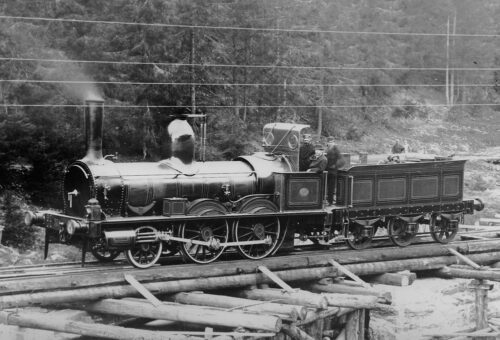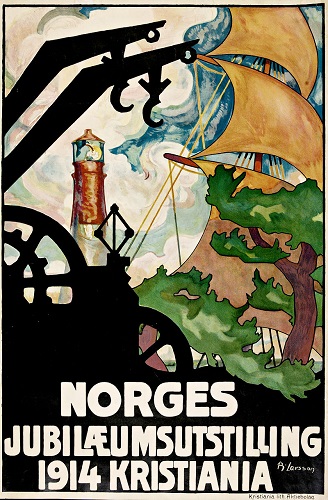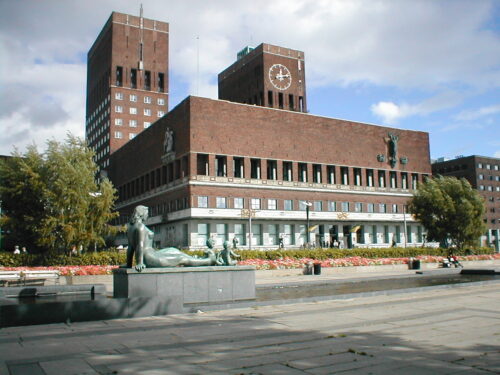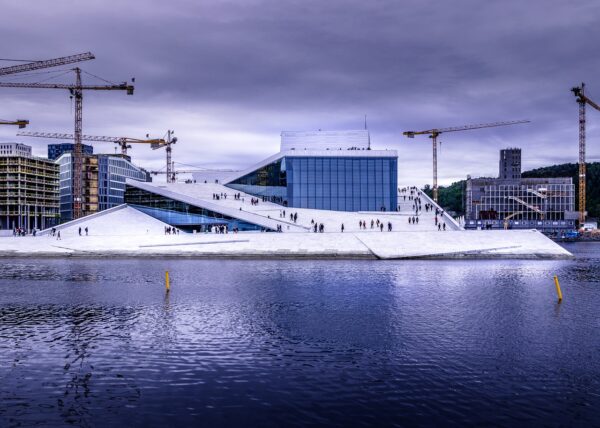Maturity
In 1854 Oslo gets its first railway leading to Eidsvoll, while in 1866 the building of Norwegian Parliament, the Storting, opens its gates for the parliament members for the first time. The city’s population explodes with poor people from all over the country flocking to the capital to find a job, reaching 200.000 at the end of the century, from 40.000 in 1850. The influx of workers creates a rapid expansion of the city’s limits with Old Oslo quickly incorporated as one of Kristiania’s districts.


After more than 40 years of operation inside the Royal Palace, the National Gallery Museum opened the doors of its new building in 1882. At the same time, River Akerselva which flows through the city becomes the cradle of industrialization in Norway, with many factories built along its shores.
The wide streets of Kvadraturen, like Prinsens gate, Nedre Slottsgate, and Tollbugata are lined with neoclassical business palaces several stories high. To a great extent, Old Oslo we know today as a historic district is created in that period between the start of the 19th century and the first decades of the 20th century.
In 1894 the electric tram begins its first testing route and soon after becomes the city’s symbol of the brave new world of science. Five years later the grandiose Nationaltheatret opens its doors to the people of the Norwegian capital, sealing the city’s role as the cultural powerhouse of Norway.



The prestige of both the country and the city would be greatly revamped with the help of a Swedish national named Alfred Nobel. In his will, Nobel made the Norwegian Parliament responsible for the selection of the committee that would choose the candidates and the winner of the Nobel Peace Prize, one the most prominent and revered distinctions in modern history.
The first Nobel Peace Prize was awarded in 1901 to Henry Dunant for his role in the creation of the International Committee of the Red Cross and Frédéric Passy for his role in the establishment of the Inter-Parliamentary Union and several other Peace societies.


In 1905 the uncomfortable union between the Norwegian people & the Swedish crown is dissolved after an overwhelming majority in the Referendum of August 1905 (99.95%), with Kristiania becoming the capital of the independent kingdom of Norway and Prince Carl of Denmark (descended from an old line of Medieval Norwegian kings) the first King of Norway since 1387, as King Haakon VII.



A new era of prosperity characterized by the improvements & modernization of the city’s infrastructure would be celebrated in the 1914 Jubilee Exhibition honoring the centennial anniversary of the 1814 constitution.
The exhibition took place on the site of Frogner Park which had first opened its doors to the public in 1904. The exhibition managed to attract more than 1.5 million visitors. The age of optimism for the city would not even be halted by WWI since Norway followed the example of the rest of the Scandinavian countries & stayed out of the war.



In 1925 the city takes back its historic name, the name Oslo, despite the 28.000 signatures raised by the newspaper Morgenbladet against the proposal that was introduced in 1918 by 29 civil servants & had been voted on in July of 1924. When the city took up the name of Oslo, the old eastern district of the city that had preserved the same name over time became known as Gamlebyen (Old Town).
The underground metro inaugurated in 1928 would gradually unite the different districts of the growing capital. By the late 1920s, Gustav Vigeland had already completed many features of his world-famous installation of sculptures in Frogner Park such as the Monolith & the Fountain while Lars Backer had completed his first modernist works, the Skansen & Ekeberg restaurants.


In 1931, after a delay of 15 years, the new City Hall was finally starting to take its shape in the former slum area of Vikauntil but the decade of the 1930s would turn out to be rosy neither for Norwegians nor for the residents of Oslo. The economic depression that spread from the US to the rest of the world had its effect everywhere.
A sharp fall in investment was followed by an equally sharp fall in imports and public expenditure. The demand for labor was halted. The deep end of the slump came in 1932 but the situation more or less remained stagnant until the Nazi invasion of Norway in 1940 which created a whole new environment.


The Nazis occupied Norway and installed a puppet government in Oslo with the Norwegian fascist Vidkun Quisling as Prime Minister, while Akershus Fortress became the prison where the political opponents & captured Resistance fighters were kept, with its courtyard used mainly for executions.
Norwegian citizens of Jewish origin who didn’t manage to flee were sent to concentration camps, where many of them died. Martial law and massive arrests became the norm while food rations and long waiting lines led to a rampant Black market.



More than 80.000 Norwegians fled the country with King Haakon VII and the members of the pre-war government being among them. About 30.000 Norwegians voluntarily enlisted in Allied military service. The organized armed resistance movement in the country known as Milorg numbered some 40.00 armed men by the end of the war. About 15.000 Norwegians fought on the Nazi side.
After 5 long years, the Germans surrendered Oslo to an Allied Military mission on the 8th of May, 1945. On 7 June, the day of the 40th anniversary of the dissolution of Norway’s union with Sweden, King Haakon VII and the members of the royal family arrived in Oslo



After the war the city resumed its role as the central life flow of the Norwegian economy, quickly expanding on all sides & incorporating nearby regions like Aker, the new City Hall in Vika finally opened its gates while new multi-story buildings were shyly making their appearance in the city’s new suburbs to house the increased population who flocked in the Norwegian capital that reached half a million people by 1951.


In the 1960s Oslo saw a boom not only in its population but also in the construction of modernist concrete & glass low-rises now regarded as an eyesore. However, Norway’s economic progress in the years that followed turned Oslo into a powerful business center with a bustling urban center & international appeal, a melting pot of many nationalities & cultures, and a hub of new technologies.
The modern city of Oslo is characterized by impressive new landmarks such as the new Opera House or The Astrup Fearnley Museum of Modern Art & its impressive skyscraper skyline that narrate exactly what the city of Oslo can offer to its visitor and permanent resident today. A perfect example of a thriving, contemporary city with a bright future ahead.




